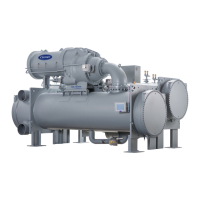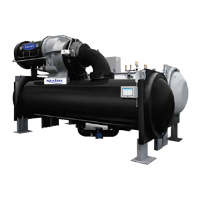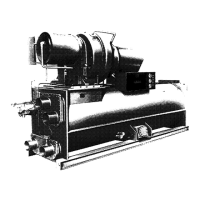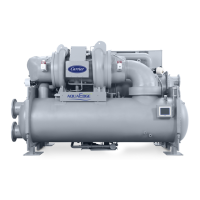Table 4 — Capacity Overrides
OVERRIDE
CAPACITY CONTROL
FIRST STAGE SET POINT
SECOND STAGE
SET POINT
OVERRIDE
TERMINATION
View/Modify
on CVC Screen
Default
Value
Configurable
Range
Value Value
HIGH CONDENSER
PRESSURE
SETUP1
125 psig
(862 kPa)
90 to 165 psig
(620 to 1138 kPa)
.Override
Set Point
+ 2.4 psid (16.5 kPad)
,Override
Set Point
HIGH MOTOR
TEMPERATURE
SETUP1
.200 F
(93.3 C)
150 to 200 F
(66 to 93 C)
.Override
Set Point
+10° F (6° C)
,Override
Set Point
LOW REFRIGERANT
TEMPERATURE
(Refrigerant
Override Delta
Temperature)
SETUP1 3° F (1.6° C)
2° to 5° F
(1° to 3° C)
<Trippoint
+ Override
DT –1° F (0.56° C)
.Trippoint
+ Override
DT +2° F (1.2° C)
HIGH COMPRESSOR
LIFT
(Surge Prevention)
OPTIONS
Min: T1 — 1.5° F
(0.8° C)
P1 — 50 psid
(345 kPad)
Max: T2 — 10° F
(5.6° C)
P2 — 85 psid
(586 kPad)
0.5° to 15° F
(0.3° to 8.3° C)
30 to 170 psid
(207 to1172 kPad)
0.5° to 15° F
(0.3° to 8.3° C)
50 to 170 psid
(348 to 1172 kPad)
None
Within Lift Limits
Plus Surge/HGBP
Deadband Setting
MANUAL GUIDE VANE
TARGET
CAPACITY Automatic 0 to 100% None
Release of
Manual Control
MOTOR LOAD —
ACTIVE DEMAND LIMIT
MAINSTAT 100% 40 to 100%
>5% of
Set Point
2% Lower
Than Set Point
LOW DISCHARGE
SUPERHEAT
OVERRIDE
Calculated Minimum
Superheat
for Conditions
None
2° F (1.1° C)
Below Calculated
Minimum Superheat
1° F (0.56° C)
Above Calculated
Minimum Superheat
Oil Cooler — The oil must be cooled when the com-
pressor is running. This is accomplished through a small,
plate-type heat exchanger (also called the oil cooler) located
behind the oil pump. The heat exchanger uses liquid con-
denser refrigerant as the cooling liquid. Refrigerant thermo-
static expansion valves (TXVs) regulate refrigerant flow to
control the oil temperature entering the bearings. The bulbs
for the expansion valves are strapped to the oil supply line
leaving the heat exchanger, and the valves are set to main-
tain 110 F (43 C).
NOTE: The TXVs are not adjustable. The oil sump temper-
ature may be at a lower temperature during compressor
operations.
Remote Start/Stop Controls — Aremote device, such
as a timeclock that uses a set of contacts, may be used to
start and stop the chiller. However, the device should not be
programmed to start and stop the chiller in excess of 2 or
3 times every 12 hours. If more than 8 starts in 12 hours (the
STARTS IN 12 HOURS parameter on the MAINSTAT screen)
occur, an excessive starts alarm displays, preventing the chiller
from starting. The operator must press the RESET
softkey
on the CVC to override the starts counter and start the chiller.
If the chiller records 12 starts (excluding recycle starts) in a
sliding 12-hour period, it can be restarted only by pressing
the RESET
softkey followed by the LOCAL or CCN
softkey. This ensures that, if the automatic system is mal-
functioning, the chiller will not repeatedly cycle on and off.
If the automatic restart after a power failure option (AUTO
RESTART OPTION on the OPTIONS screen) is not acti-
vated when a power failure occurs, and if the remote contact
is closed, the chiller will indicate an alarm because of the
loss of voltage.
The contacts for remote start are wired into the starter at
terminal strip J2, terminals 5 and 6 on the ISM. See the cer-
tified drawings for further details on contact ratings. The con-
tacts must have 24 vac rating.
Spare Safety Inputs — Normally closed (NC) dis-
crete inputs for additional field-supplied safeties may be wired
to the spare protective limits input channel in place of the
factory-installed jumper. (Wire multiple inputs in series.) The
opening of any contact will result in a safety shutdown and
a display on the CVC. Refer to the certified drawings for
safety contact ratings.
Analog temperature sensors may also be added to the mod-
ule (SPARE TEMP #1 and #2). The analog temperature sen-
sors may be configured to cause an alert or alarm on the CCN
network. The alert will not shut the chiller down. Config-
uring for alarm state will cause the chiller to shut down.
Spare Safety Alarm Contacts — One set of alarm
contacts is provided in the starter. The contact ratings are
provided in the certified drawings. The contacts are located
on terminal strip JP, terminals 15 and 16.
Refrigerant Leak Detector — An input is available
on the CCM module [terminal 15-5 (−) and J5-6 (+)] for a
refrigerant leak detector. Enabling REFRIGERANT LEAK
OPTION (OPTIONS screen) will allow the PIC II controls
to go into an alarm state at a user configured level
(REFRIGERANT LEAK ALARM mA). The input is con-
figured for 4 to 20 mA by setting the DIP switch 1 on SW2
at the ON position, or configured for 0 to 5 vdc by setting
switch 1 at the OFF position. The output of the refrigerant
leak detector is displayed as REFRIGERANT LEAK SEN-
SOR on the MAINSTAT screen. Fora0to5vcdinput, 0 vdc
input represents 4 mA displayed and 5 vdc input represents
20 mA displayed.
Condenser Pump Control — The chiller will moni-
tor the condenser pressure (CONDENSER PRESSURE) and
may turn on the condenser pump if the condenser pressure
becomes too high while the compressor is shut down. The
condenser pressure override (COND PRESS OVERRIDE)
parameter is used to determine this pressure point. COND
PRESS OVERRIDE is found in the SETUP1 display screen,
which is accessed from the EQUIPMENT SERVICE table.
The default value is 125 psig (862 kPa).
If the CONDENSER PRESSURE is greater than or equal
to the COND PRESS OVERRIDE, and the entering con-
denser water temperature (ENTERING CONDENSER
WATER) is less than 115 F (46 C), the condenser pump will
36

